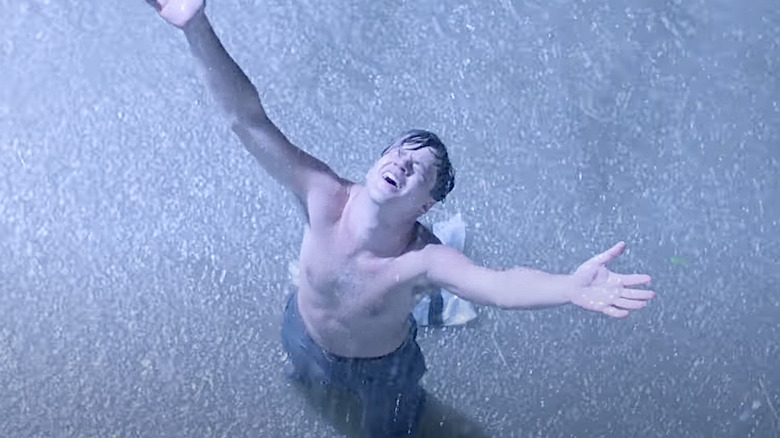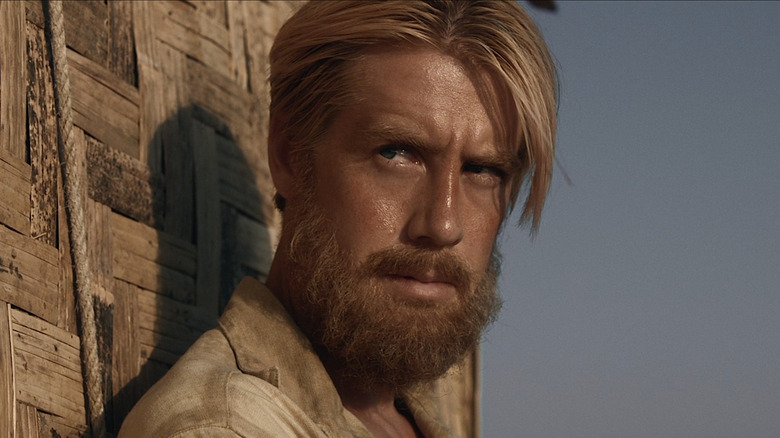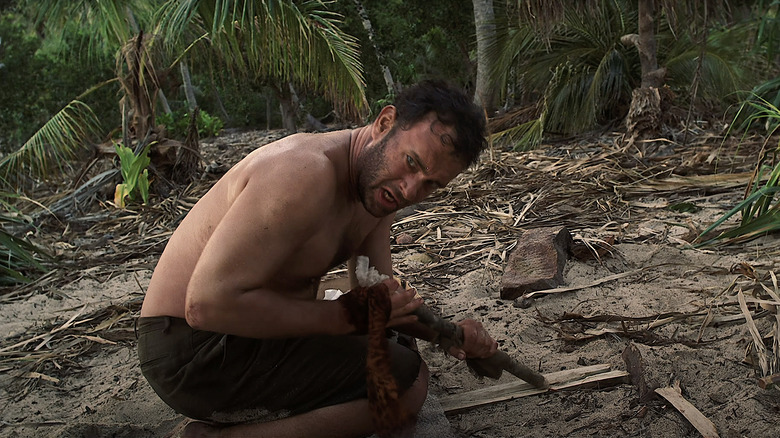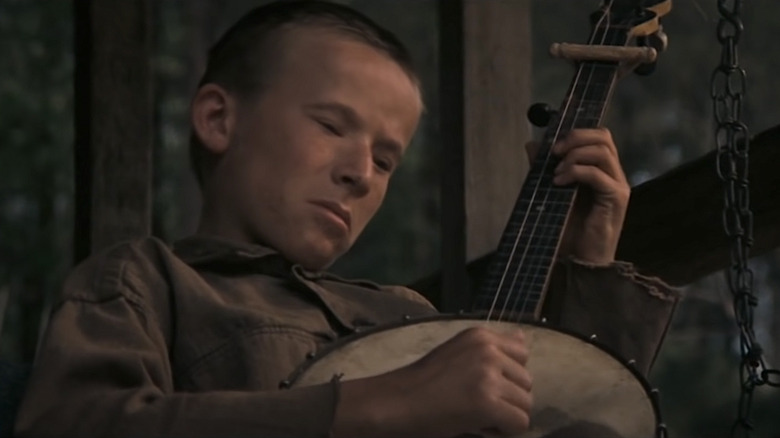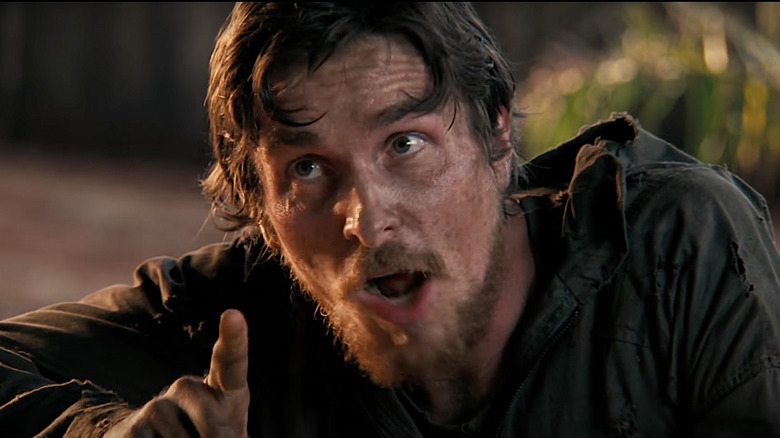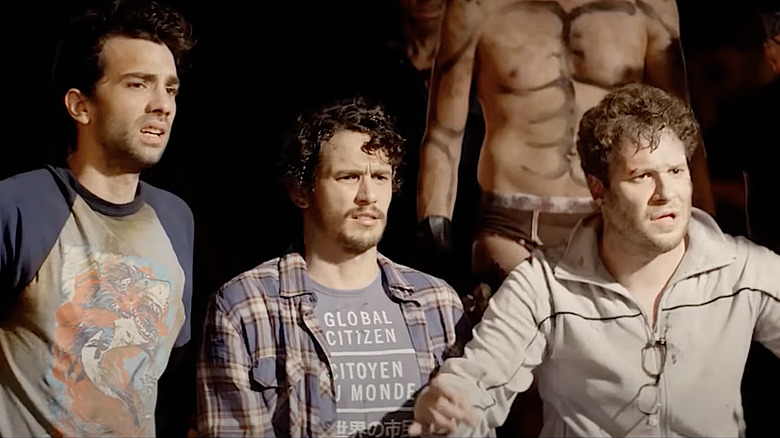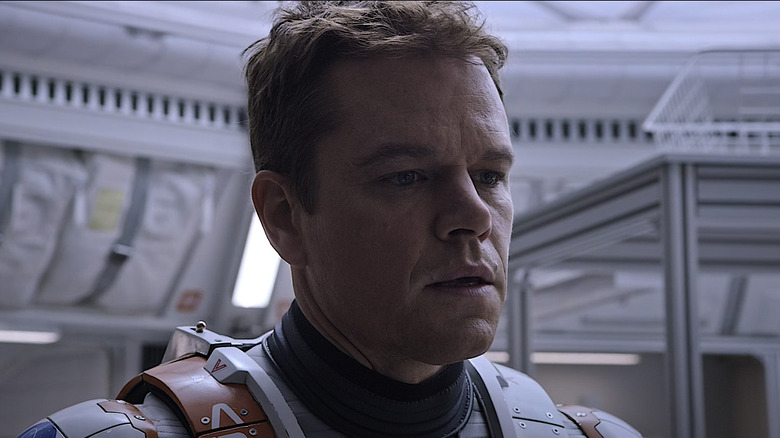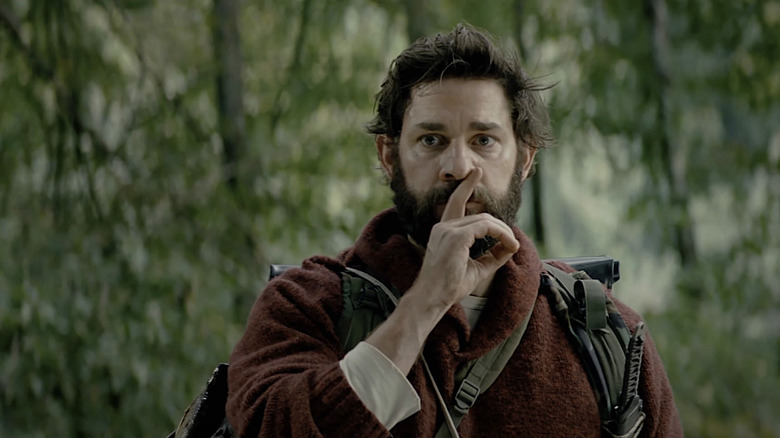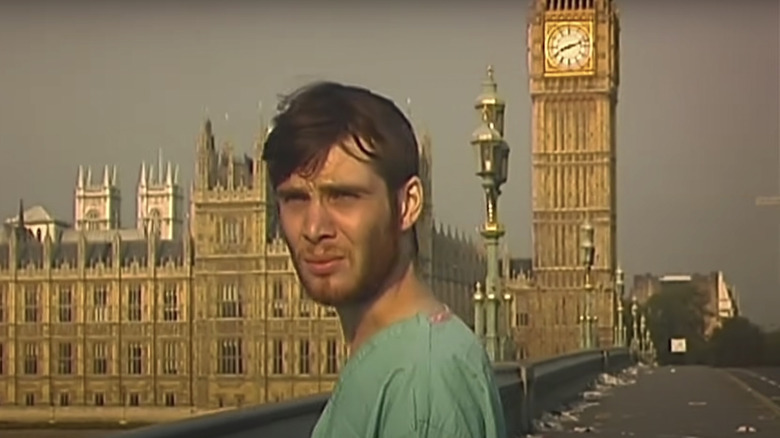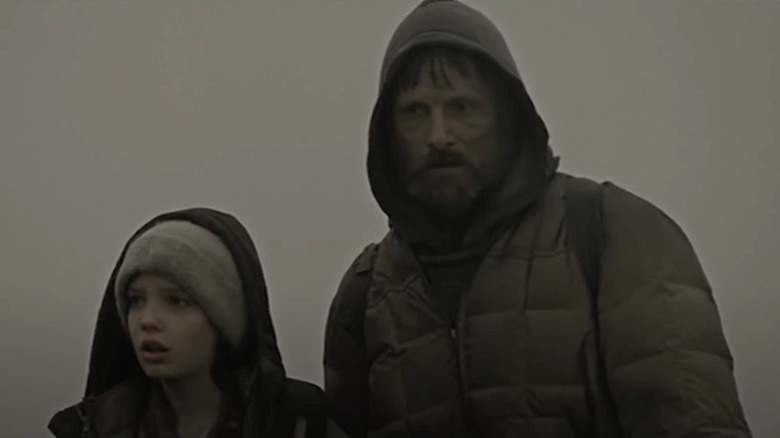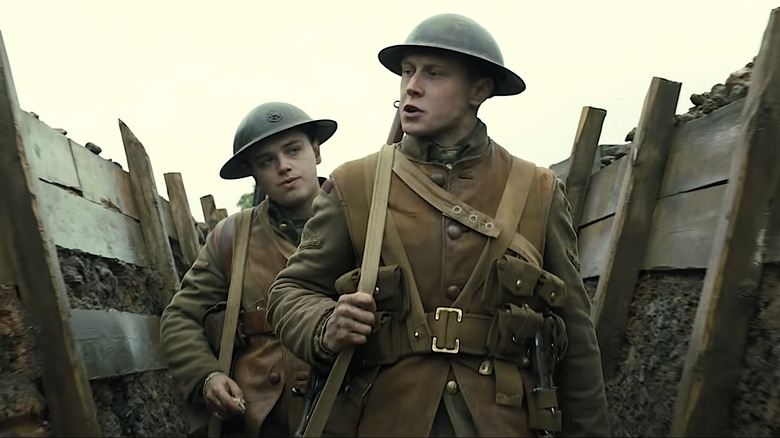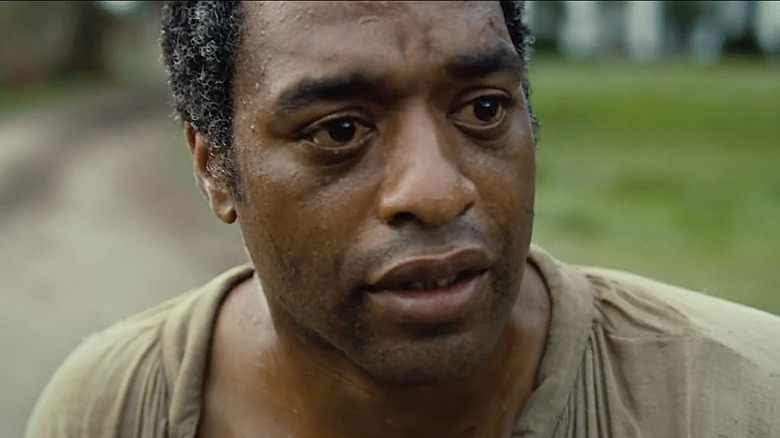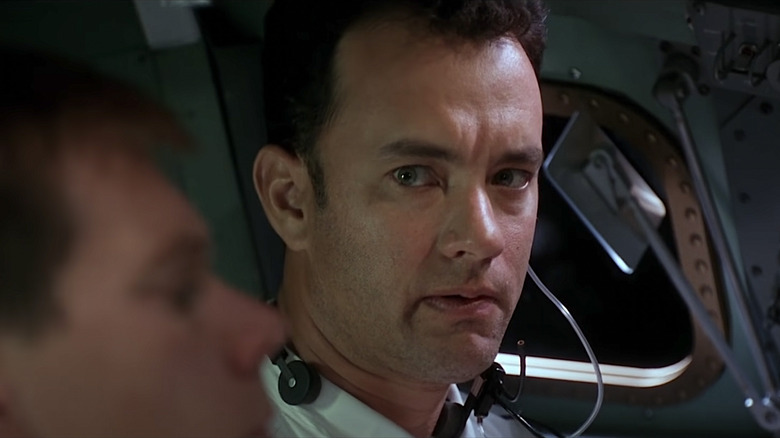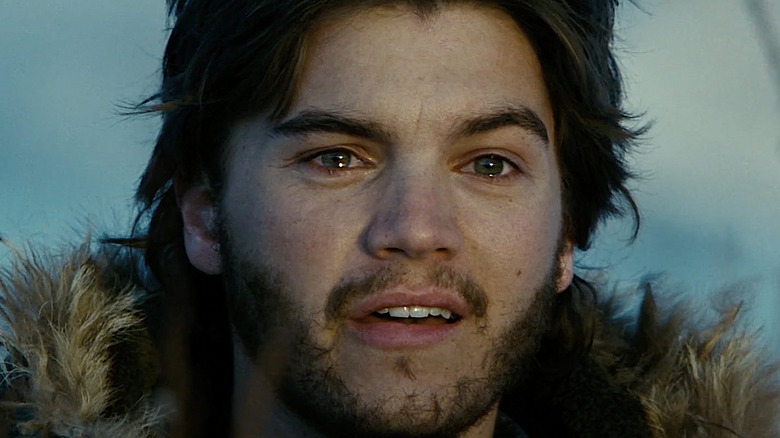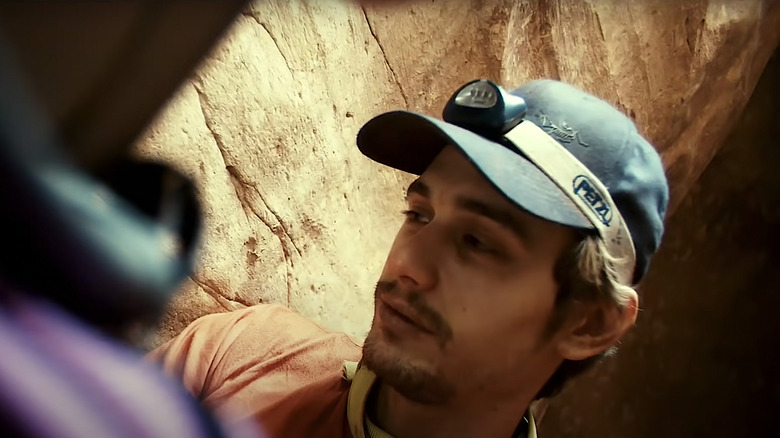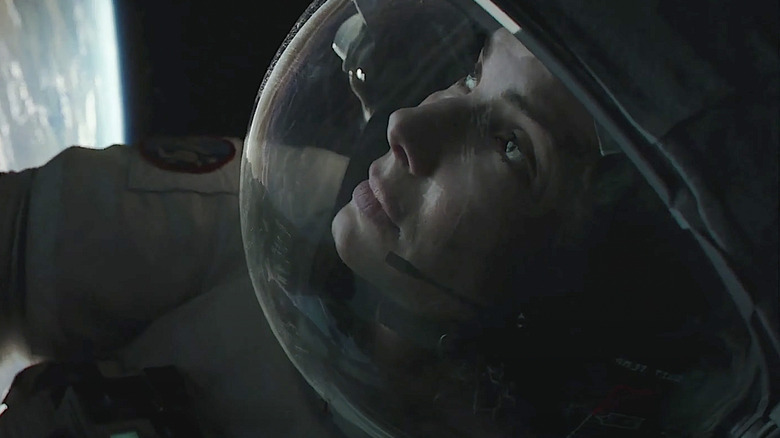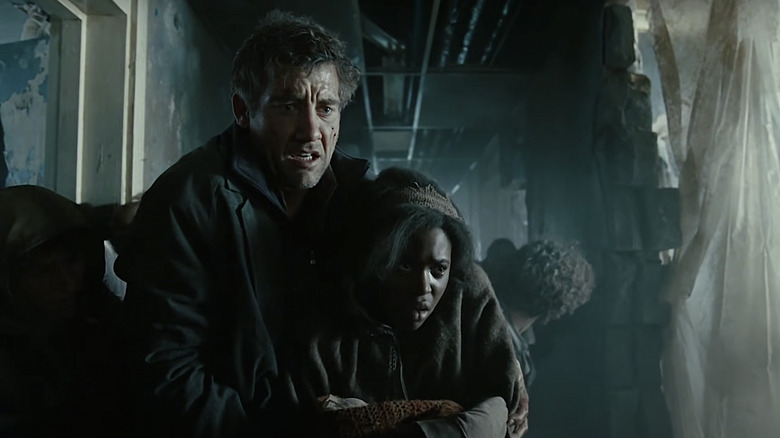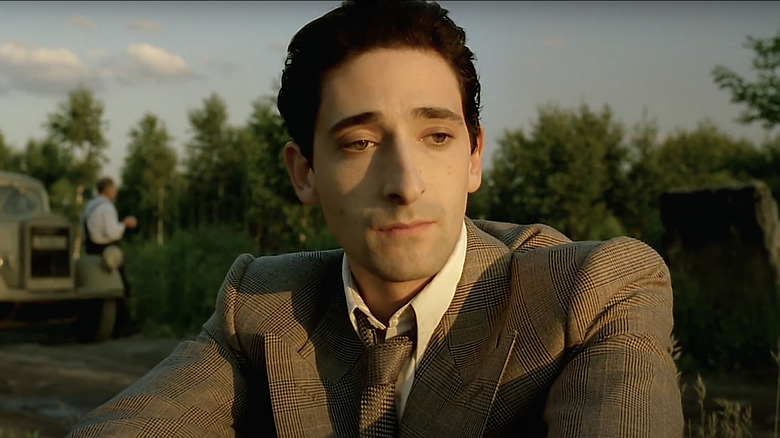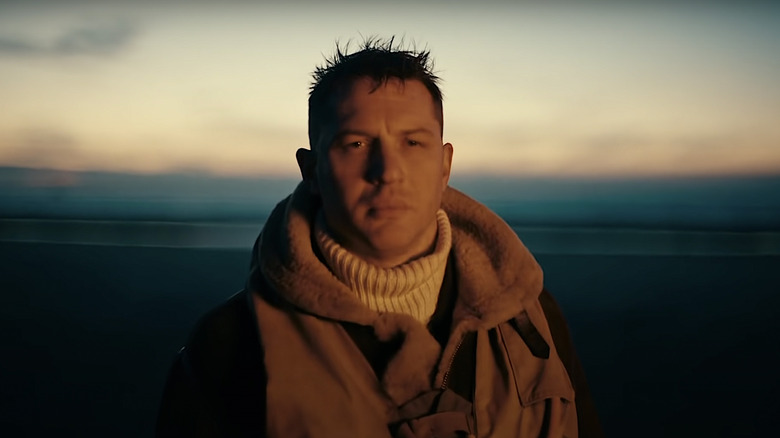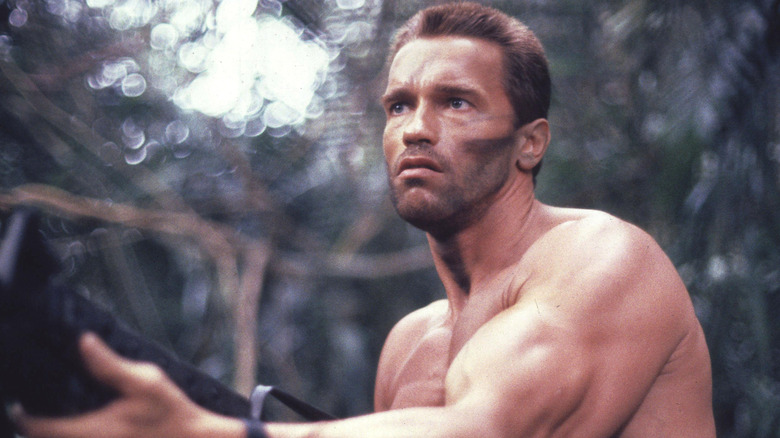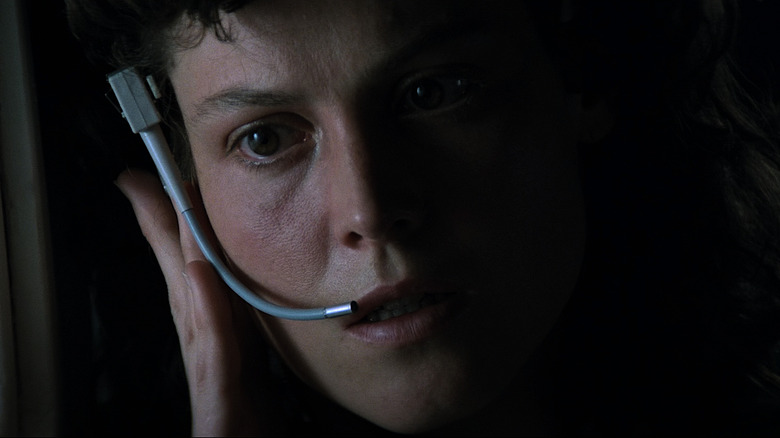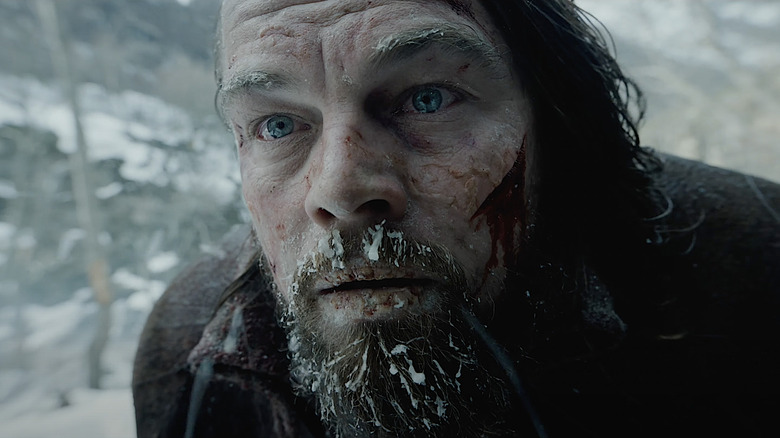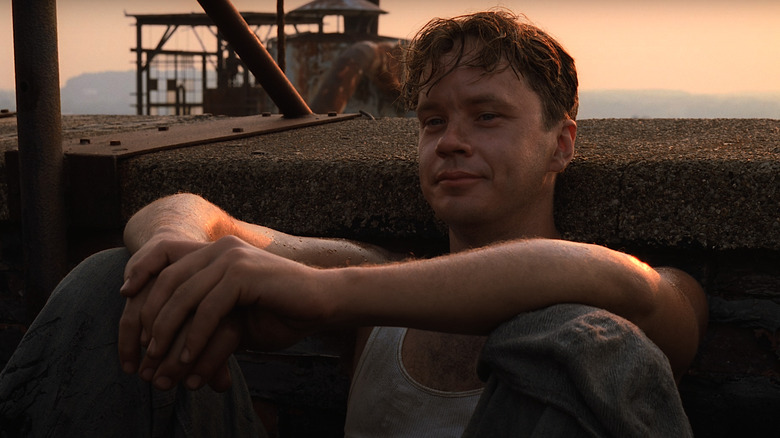The 22 Best Survival Movies Ranked
Staying alive is the primordial prime directive for life. This deep need to survive pushes humans into incredibly dramatic battles with reality. That's why so many of the stories below are true. Near-death narratives strip away the trappings of society and place their heroes into a state of nature. These protagonists are stranded, starving, mauled, and even disfigured. And yet, they take what's left and fight to keep breathing.
The earliest known human stories have survival elements, of course. "Gilgamesh" is a quest for immortality — the ultimate survival plot. "Beowulf" and Homer's epics both survive harrowing quests, too, but the true survival story is simpler. There is no grand search for glory or reward; It's just the naked struggle to stay tethered to this mortal coil.
Survival movie heroes don't usually choose their adventures. The universe plucks them from ordinary lives and throws them into extraordinary, yet elementary, battles with mortality. First, they have to find the fortitude to overcome this sheer bad luck, and then, the determination to take what's left and keep living. These are the 22 best survival movies, ranked.
22. Kon-Tiki
In 1947 Norwegian anthropologist Thor Heyerdahl wanted to prove a wild theory that Polynesia was populated by ancient indigenous South Americans who traversed thousands of miles of ocean to settle there. He'd first lived among Pacific tribes for years and then built a balsa wood raft and set to sea to prove that native Americans did the same 1500 years prior.
Never mind that by modern standards this experiment proves nothing but the guts of Thor and the men who joined him. Decades later, DNA evidence first refuted Heyerdahl's notion, but then a more modern study supported it. In either case, the bold adventure did demonstrate that navigating the vast Pacific on a wooden raft was possible, and the men shot a film along the way that won the Oscar for best documentary in 1952.
This simple black and white film inspired the 2012 "Kon-Tiki" dramatization that captures this perilous voyage, buoyed by the quiet determination of Heyerdahl (Pål Sverre Hagen). Cinematographer Geir Hartly Andreassen's work is immaculate. In one scene, his camera floats from the rickety raft, into outer space, and back down, in one continuous shot. It's a composite effect, of course, but perfectly executed, like the rest of this daring seafaring adventure. The science of Pacific Islander origins may not be settled, but the bravery of Thor and his band of blonde and badly sunburned Norwegian sailors is undeniable.
21. Cast Away
Tom Hanks making friends with a volleyball in the two-and-half-hour one-man show of "Cast Away" is definitely the peak of the desert island genre.
Hanks, however, went into this 2000 film worried about the cliches of this premise. "Because there is a standard way of telling this story, and that's to have a rich, snotty guy who's obviously not in touch with what's important and blah, blah, blah, and then he learns a lesson and he's not like that anymore. But Chuck learns no great lessons." Instead, this film focuses on the practical details of survival, as Hanks further explained.
Screenwriter William J. Boyle actually stranded himself for days in a remote region of Mexico and many of his actual experiences, like the volleyball and his struggle to make fire, are in the film. You don't often hear of scribes going method, but it amounts to a survival movie that feels authentic. The emotional side of this movie works, too. If you've seen the reality series "Alone," you may have noticed contestants who are the best survivalists are the ones who want to be rescued first. With their basic bodily needs met, the isolation is what takes a toll. Desert island survival is way more than a physical challenge, it's "... an emotional, spiritual one as well," Boyle told The Austin Chronicle.
20. Deliverance
"Deliverance" from 1972 is the ultimate camping-trip-from-hell film. The story follows four city slickers (Jon Voight, Burt Reynolds, Ned Beatty, Ronny Cox) who venture into the wilds of rural Georgia to go canoeing. Soon, the get-away from the grind turns into a deadly fight for survival as they're pursued by relentless backwoods locals.
"Deliverance" is scary because it effectively makes a curiosity of "hillbilly" culture. The friends come across a young local boy with a banjo and Ronny Cox's character "Drew" begins a call-and-response musical duel with the odd-looking youth, who is clearly a musical savant. It's the group's first real contact with these exotic rural folk. As the child begins to play circles around Drew, it's a preview of the uncanny country competency of these sinister locals.
Both "Deliverance" and "Easy Rider" from 1969 take a dim view of flyover America. In both cases, poor rural whites are portrayed as toothless, murderous bigots, but "Deliverance" takes the caricature a step further. The hillbilly villain is a sexual predator and sadist on the hunt. The film can be read as a scathing early salvo in the red-blue culture war still raging today. It's also effectively terrifying and full of stunts that put the excellent cast in real danger. "Deliverance" remains one of the scariest survival movies ever made.
19. Rescue Dawn
If war is hell, becoming a prisoner of war during Vietnam was the ninth circle. "Rescue Dawn" tells the true story of Dieter Dengler, an American Navy pilot shot down over Laos in 1966. He spent five brutal months in a Viet Kong POW camp, enduring unspeakable torture, but on July 4, he and four other men escaped, barefoot and without supples, only to spend weeks battling the dense and inhospitable jungle in a death-defying march to salvation.
Warner Herzog's 2006 film covers basically the same territory as his haunting 1997 Dengler documentary "Little Dieter Needs to Fly." That film traces the hero's story from his early childhood witnessing the destruction of World War 2 and vowing to become a pilot. Herzog, of "Grizzly Man" fame, may be the greatest living documentarian, and he brings his vivid watchfulness to this dramatization. Christian Bale is fantastic as Dieter, and since Herzog is used to just letting his subjects tell their story, it's clear the director has given this notoriously serious Hollywood megastar creative room to fully embody this man's arduous travails. Bale and Herzog will have you feeling Dieter's pain.
18. This Is The End
Blockbuster movie premieres are a bummer for the press. We stand for hours lined up along a red carpet for the fleeting opportunity to shout questions as movie stars make a bee-line for E! network cameras. It's no one's fault. If Leo or Brad gave time to every lowly blogger shouting their name, their movie would never open.
That wasn't the case with "This Is The End" in 2013. Writer-director Seth Rogen and cast made lots of time for reporters and then invited us to the screening in a small lower Manhattan theatre. It was 147 minutes of uproarious laughter, but despite the packed house, Rogen's famously deep chortle rose above even the apocalyptic sounds of the end of the world.
Yes, Seth Rogen goes to his own movies and then laughs hysterically, at himself. And it was totally justified. Rogen, Jonah Hill, Danny McBride, Craig Robinson, and James Franco play absurd versions of themselves hunkering down as a biblical end-time comes for Los Angeles. The capricious way Rogen's script dispatches stars like Aziz Ansari, Michael Cera, Rihanna, and many more, is fantastically deviant. The frat-house humor that follows, like McBride's turn as cannibal warlord, is incredibly on-brand. Laughter is infections so maybe Rogen cracking himself up tricked us, but no, upon repeat viewing, this Armageddon survival comedy kills in every way.
17. The Martian
Ridley Scott's excellent 2015 Mars survival film follows Mark Watney (Matt Damon) trapped on the red planet's surface and assumed dead. NASA discovers they've left a man behind, but since it's a bit of a trek, Wayney must science his way to survival over the course of nearly two years in isolation.
"The Martian" is based on the meticulously researched sci-fi novel by Andy Weir. Like all the best survival stories, it's a procedural that hinges on the life-sustaining details. Weir is a self-described science nerd with a serious love of chemistry and found interesting ways to weave his passions into the narrative without getting tediously technical. The author first published the book online for free, and then via Amazon for just .99 cents. The feedback was so great he soon landed both a legit book contract and a movie deal in a single week, according to Business Insider. Weir wasn't very involved in the movie production, but Scott's film doesn't shy from the technical nuances that made the original PDF such a cult success. If human astronauts ever really touch down and live on Mars, it would be best if a Mark Watney type is there to troubleshoot.
16. A Quiet Place Part 1 & 2
The biggest revelation from "A Quiet Place" is this: wow, Jim from "The Office" is a really, really good director.
Writer-director John Krasinski and wife Emily Blunt play parents to three young children living in upstate New York and forced to live in silence to avoid a race of possibly extraterrestrial but blind monsters who hunt based on sound. The sequel expands on the same story and has the same respect for the audience, never telling us too much about how all this happened.
Krasinski understands the unknown is part of the thrill of the moviegoing. In fact, the first film has no talking in the opening 30 or so minutes. "A Quiet Place" could be taught in film school as the example par excellence of the prime directive for every filmmaker: show, don't tell! Following this rule is probably easier when your characters will be killed if they break it, but it amounts to two of the most suspenseful survival movies ever.
15. 28 Days Later
Danny Boyle's riveting 2002 undead masterpiece "28 Days Later" is the scariest of all brain-eating thrillers.
Cillian Murphy plays a London-based bike messenger who wakes up in a hospital dehydrated and starving to find the world has ended. He has no idea animal rights activists have recently freed chimps infected with a "rage" virus and unleashed a zombie apocalypse.
This is an intentionally lo-fi work shot largely with cheap consumer digital cameras, creating a grainy digital version of George Romero's low-resolution film look. "28 Days Later" scribe Alex Garland also wrote Boyle's "The Beach" and confirmed to EW that Romero's "Dawn of the Dead" and "Day of the Dead" were big inspirations for the story too. The references are explicit but these are not your daddy's zombies. The rage virus has created a race of fast and ferocious undead cannibals. The whole viral angle will have your heart pounding as Murphy's hero evades the "infected." And, like any good work in the genre, the only thing more dangerous than zombies are the kind of humans who survive a zombie apocalypse.
14. The Road
"The Road" is based on the Cormac McCarthy novel of the same name. McCarthy's books, like "No Country For Old Men" or "Blood Meridian," are metaphors for the end of the world, and they use the lawless American west as post-apocalyptic hellscapes. In "The Road,' McCarthy got more literal.
In director John Hillcoat's 2009 adaptation, a man (Viggo Mortensen) and his wife (Charlize Theron) wake up to find the whole world seems to be on fire. The unnamed man calmly fills the bathtub. It's a subtle detail that tells you he instantly realizes life as he knew it is over. His wife is tragically less adaptive to this unexplained disaster and Mortensen and his son (Kodi Smit-McPhee) set out on a perilous journey of survival.
"The Road" is a bleak film, steeped in ash-gray cinematography, but faithfully adapts the excellent source material and is filled with the author's eye for details about survival on a planet burned to the ground. As Mortensen's devoted dad inhales a world of smoke, it's a brutal reminder that if suddenly life was a fight just to live, none would be at full strength to face it.
13. 1917
"1917" got a lot of attention for the long-take format in which director Sam Mendes made this entire World War 1 survival tale appear as if it was a single continuous, uninterrupted shot.
Audiences don't tend to care about technical tricks. Have you ever tried explaining aspect ratios to a non-movie nerd? What does resonate is the story, and to that end, the long-take conceit of "1917" is a victory. It locks us into the premise as two young soldiers (George MacKay and Dean-Charles Chapman) are tasked to deliver a message past enemy lines that could save 1,600 of their own men, including one of their brothers, played by Richard Madden.
In the world of film theory, each cut is considered an opportunity for distraction. Cinematographer Rodger Deakins and the crew rehearsed for four months to pull off the action inside each complex shot. Numerous lengthy sequences were then stitched together with some classic editing tricks like match cuts to create the illusion the film is one continuous take. It adds up to one of the most engrossing stories of survival ever shot as the men stave off death in this brutal war.
12. 12 Years a Slave
"12 Years A Slave" like "The Shawshank Redemption" is as much about survival of the spirit, as the flesh.
"I will survive. I will not fall into despair. I will keep myself hardy until freedom is opportune." That's the moving battle cry of Solomon Northup (Chiwetel Ejiofor), a free-born Black man abducted and sold into slavery on a plantation run by a cruel master of human chattel played unflinchingly by Michael Fassbender.
Steve McQueen's Oscar-winning film is based on the real Northrup's 1853 memoir of the same name. Some of the details are changed but the essential story of this unbreakable man is all true. Northrup was an accomplished violinist living in upstate New York just before the Civil War. He was adducted by slavers and eventually helped to freedom by a sympathetic Canadian abolitionist named Samuel Bass (played in the film by Brad Pitt). Like "Roots," "Glory," or "Lincoln", this is a seminal Hollywood portrayal of American slavery, and contains both the best and worst of humanity.
11. Apollo 13
Ron Howard's 1995 retelling of the disastrous 1970 "Apollo 13" moon mission is a riveting survival procedural. The public fanfare surrounding lunar exploits had died down since Neil Armstrong took his small step, but the nation was again riveted when an explosion started spewing oxygen into space on this aborted moon landing. Jim Lovell (Tom Hanks) leads the team of stranded astronauts and Ed Harris plays the legendary Gene Kranz, coordinating the response back at mission control as engineers scramble to piece together a solution.
What really blows up in "Apollo 13" is the illusion that 20th-century space travel could be routine. The thinnest metal and most delicate instruments were insulating these men from oblivion. NASA's early astronauts were specifically picked for their ability to stay level-headed in the face of certain death. That's "The Right Stuff" of legend, and why many space aces were first daredevil test pilots. But these men were also brilliant, and none of them had a chance at survival without their steely resolve and elite smarts.
10. Into The Wild
"Into The Wild" is about a young idealist who rejects human society, but enchants every actual human he meets. It's based on the 1996 non-fiction book by Jon Krakauer, itself based on a lengthy essay by Chris McCandless. McCandless was an adventure, wanderer, and academic high achiever who became oddly radicalized by romantic writers like Henry David Thoreau.
The 2007 film adaptation directed by Sean Penn portrays McCandless (Emile Hirsch) as a man alienated from his family as he becomes a post-grad know-it-all who thinks he's found the one true path to enlightenment. He's an intellectual with a nomad's soul and sets out into the Alaska wilds to detach from society's ills. It's in solitude he realizes it's actually the people he left behind that give life meaning.
What's magical about Hirsch's McCandless is he's such a charismatic figure. Everywhere he goes, he's wanted and adored. He forms a deep bond with a farmer (Vince Vaughn) becomes an object of unrequited passion by a young commune girl (Kristen Stewart), and then a quasi-adopted grandson to a lonely old man (Hal Holbrook). He's beloved by all, but his ideas and wild heart mean he can't stay put. Penn's film, propelled by Pearl Jam frontman Eddie Vedder's perfectly strummed score, captures the searching power of youthful idealism, and the terrible cost.
9. 127 Hours
"127 Hours" tells the true story of 27-year-old climber Aron Ralston who got his arm stuck between two rocks while canyoneering in Utah. Ralson recklessly told no one where he was going and so couldn't expect a rescue. He was tapped for five days until he realized that the only way to escape with his life was to cut off his own arm.
The challenge for Danny Boyle's excellent 2010 film starring James Franco was to capture the drama of a story where the protagonist can't even move. The tale includes plenty of obvious tension like a flash flood that almost drowns Ralston. That's all very gripping, but really, this is an internal journey as the combination of exposure, desperation, and spiritual delirium, which push this protagonist to the place of desperation necessary to attempt the gruesome life-saving operation. Boyle and lead editor Jon Harris take you inside the mind of this man in a harrowing journey way past ordinary mental and physical limits.
8. Gravity
"Gravity" is like an exploding Rube Goldberg device that just keeps twisting into new spectacular shapes. It's one of the most incredible pieces of visual design ever put to film and director Alfonso Cuarón and cinematographer Emmanuel Lubezki both won Oscars for their efforts in 2014.
Sandra Bullock and George Clooney play astronauts servicing the Hubble telescope when a satellite collision causes an ever-expanding debris field orbiting the earth at thousands of miles an hour. Cuarón and his son Jonás Cuarón wrote the ingenious screenplay but waited over four years for technology to catch up to their vision.
"Gravity" borrows motion capture advancements from James Cameron's "Avatar," which helped create the long-takes that keep you trapped alongside Bullock as she navigates from one crisis to the next. The entire film is composed of just 157 different shots, each lingering an average of 40 seconds (the Hollywood norm is just three seconds). Many action flicks feature this many cuts in one poorly staged fight scene. Lubezki's camera rarely blinks so you cant take your eye off the stomach-churning two-hour free fall that is this towering achievement of cinematic engineering.
7. Children of Men
Seven years before the dynamic duo of director Alfonso Cuarón and cinematographer Emmanuel Lubezki stunned audiences with "Gravity," they constructed "Children of Men." It's another survival classic that deploys their love of elaborately blocked long-take action set-pieces.
"Children of Men" is the story of an unusual plague (maybe?) that suddenly renders humanity infertile. Free society collapses as earth's power structures realize their days are numbered. Clive Owen plays a minor civil servant who finds the possible key to survival: the last pregnant woman. He must usher her to safety in a world gone mad.
This is a grim dystopian future where freedom and moral order are crushed in a massive power grab justified by the coming doom. If the human race has no future, what does right or wrong matter in the present? The gripping and sacrificial survival plot in Cuarón and Lubeski's visual masterpiece is a good case against this nihilistic reasoning.
6. The Pianist
Adrien Brody is one of Hollywood's best actors, but certainly cemented that reputation in his Oscar-winning turn as a Jewish pianist in Poland who survives Hitler's terrifying World War 2 purges.
This achingly beautiful 2002 film is based on the autobiography written by Wladyslaw Szpilman, "The Pianist: The Extraordinary True Story of One Man's Survival in Warsaw, 1939-1945." Szpilman is initially forced into the horrifying ghettos of Warsaw but eventually hides in the ruins of his city as his people are murdered in the streets, starved to death, or shipped off to death camps.
Brody lost 30 pounds to play the starving Szpilman, who had to scrounge and freeze during his arduous years in hiding. The tall and often muscular actor got down to a horrifying 129 pounds and then gained it all back during filming because the "The Pianist," like many productions, was shot in reverse order. Brody also learned large portions of Chopin compositions by heart. The actor's extreme commitment and quiet strength carry this moving film about one man's unlikely but true Holocaust survival story.
5. Dunkirk
"All we did is survive," laments Harry Styles as a British soldier who braved the beaches of "Dunkirk." "That's enough," replies an old blind man handing out blankets to the haggard soldiers. The men who escaped this death trap in 1940 feel ashamed. No military wins in retreat, but Christopher Nolan's 2017 film captures the moving spirit of living to fight another day.
The evacuation of Dunkirk was a pivotal moment in World War 2. Germany had the bulk of the British Expeditionary Force surrounded and could have crushed them on that beach, but Hitler hesitated. Many have speculated had citizen sailors not rescued these English forces from France, Britain could have fallen to enemy rule.
The survival of the free world is what's at stake in this imperfect masterpiece. Nolan deploys his signature non-linear editing, hopscotching back and forth in time over the course of multiple days. We're also volleyed between the deadly beaches, a civilian rescue boat, and a brilliant air encounter with Tom Harding as a British flying ace. The cross-cutting is superb but the tricks with time add nothing but confusion to an otherwise superb plot. It's a minor quibble. The British-born auteur has more than earned the right to lean into his temporal fixations in animating the moment his countrymen faced their most dire race against annihilation.
4. Predator
Arnold Schwarzenegger's unforgettable original turn in "Predator" from 1987 rounds out the scariest horror movie ever shot in broad daylight.
A very pumped-up Arnold plays "Dutch," a mercenary hired to rescue some politicians gone missing in the jungles of Guatemala. But Dutch and team find only a trail of mangled bodies and an inhuman force picking them off one-by-one from the trees. Schwarzenegger's final battle with this alien big-game hunter is one of the best action set-pieces of all time. Director John McTiernan ("Die Hard") builds so much fear of this monster in a suspenseful first hour that even for a muscle-bound super-soldier like Dutch, it feels like unfathomable courage to stand and fight.
"Predator" was shot entirely on location in Mexico, so "Lethal Weapon" scribe Shane Black was hired to play one of Dutch's commando comrades, not for his acting chops, but to be available for re-writes in the remote wilderness. Another incredible legend surrounding the film is Jean Claude Van Damme's original casting as the titular monster. Accounts differ as to why he left the film but the funniest is the claim that JCVD wouldn't stop throwing kicks. "You gotta stop kickboxing! Look, the Predator is not a kickboxer," a producer told Van Damme during the shoot, according to visual effects supervisor Joel Hynek, via The Hollywood Reporter.
3. Alien & Aliens
Ridley Scott's "Alien" from 1979 features the most spectacular sci-fi set ever built. The opening scene is just a roving tour of the production team's incredible craft as Scott's camera glides from room to room on this doomed deep-space mining craft.
What Scott is showing us is the physical parameters of the survival game to follow. When the crew accidentally brings an alien aboard that begins picking them off one by one, Ellen Ripley (Sigourney Weaver) must run, hide, and fight this terrifying extraterrestrial.
James Cameron somehow followed this masterpiece with an equally well-constructed survival-oriented sequel. There are more creatures but the game is the same. The first two "Alien" installments work because of Scott and Cameron's skill at building suspense, but also the terrifying creature design based on the work of artist H.R Giger. "Alien" scribe Dan O'Bannon initially met Giger in Paris while working on "Dune" and immediately the painter offered him opium. O'Bannon asked Giger why he used the drug. Giger replied, "I am afraid of my visions," according to "The Beast Within The Making of Alien." It sounds apocryphal, but one look at these drooling monsters and their eerily oblong heads and you know exactly what he means.
2. The Revenant
Revenant means a return from the dead. "The Revenant" is the story of frontiersman Hugh Glass (Leonardo DiCaprio) who is mauled by a bear, buried alive, but somehow survives and seeks vengeance on a fellow trapper, played by Tom Hardy.
"Birdman" director Alejandro González Iñárritu followed up that Oscar-winning effort with this equally kinetic masterpiece. The director again tapped his effervescent cinematographer Emmanuel Lubezki ("Gravity") who shot the entire film with only available light, and mostly at the magic hour – that brief window of ambient glow after sunset. Filmmakers like Terrence Malick have always favored this gentle lighting which utilizes all of the earth's atmosphere as one giant bounce board.
The downside is this technique turns the production into a slow grind. Temperatures on location in the Canadian wilderness plummeted to 40 degrees below zero. Iñárritu's movie was over budget and was forced to South America when conditions got too extreme. The director told The Wrap, "There's absolutely nothing that I kept in my pockets — that's all that I've got to give. It almost killed me, too ... maybe having died and been reborn many times during the shooting, I feel extraordinarily proud." This is filmmaking at its most daring, vivid, and beautiful.
1. The Shawshank Redemption
"The Shawshank Redemption" is the ultimate tale of survival of the spirit. Tim Robbins is an inspiration in his best-ever role as that "tall drink of water" Andy Dufresnes. He's been wrongly convicted of killing his wife and sent to the brutal and corrupt Shawshank penitentiary. There, Andy reminds Red (Morgan Freeman) and a small group of fellow convicts that a whole world still exists beyond the prison's demoralizing walls.
Shawshank is based on Stephen King's novella "Rita Hayworth and the Shawshank Redemption." It's also a story of a daring escape, but that's only possible because Dufresnes risks his life to keep his soul alive. This 1994 film is the best ever adaptation of King's work and scored numerous well-deserved Oscar nods in 1995.
Interesting casting fact: Brad Pitt was slated to play Tommy, the illiterate young convict who comes under Andy's tutelage. But after the actor's breakout in "Thelma and Louise," he pulled out for a lead in the solid, but far less seminal, "Interview With A Vampire."
